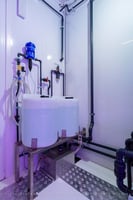13. How to manage EC and pH on a day-to-day basis in hydroponic cultivation
This article is part of the practical series on hydroponics, designed to take you step by step from theory to daily management of your plant.
Managing EC (Electrical Conductivity) and pH well every day is the difference between plants that "survive" and plants that explode with growth. It is not enough to set the values once: the nutrient solution is a dynamic system that is constantly changing.
Let's see what happens day by day, how to read the values, and what to do-practically-when they are not where they should be.
Why EC and pH change every day
Even if you don't touch anything, EC and pH never stay perfectly still. Here's why:
-
Plants selectively absorb nutrients
They don't "drink" everything evenly: at some times they absorb more nitrogen, at others more potassium, calcium, etc. This unbalances the solution. -
Water evaporates or is transpired
If water decreases and salts remain, EC rises. -
Natural chemical reactions
Some nutrients tend to slightly change pH over time. -
Incorrect top-ups
If you add only water, EC goes down; if you add only fertilizer, it goes up too much.
So managing EC and pH is a daily process, not a one-time setting.
How often to check EC and pH
It depends on the type of plant and the level of automation.
In a small hobbyist system.
-
At least 1 time per day, preferably:
-
Morning: main check
-
Evening: brief check, especially in summer or very bright lights
-
In a professional or very dense plant
-
Checking 2 times a day is standard.
-
In case of fast cycles or "sensitive" plants (baby leaf, microgreen, tender basil): even 3 checks per day at critical times (early stages after transplanting or in heat peaks).
In Tomato+ systems.
In more advanced systems, such as Horto Professional, monitoring of key parameters is integrated into automated management, minimizing manual operator intervention.
What values to keep in mind (in general)
"Perfect" values depend on the crop, but for a general foliar (lettuce, misticanza, basil, baby leaf) you can consider as an indicative reference:
-
Indicative EC: 1.2 - 2.0 mS/cm
-
Indicative pH: 5.5 - 6.5
Important:
-
always stay within the nutrient solution manufacturer's recommended ranges;
-
if you use Tomato+ pods and nutrients, follow the crop-specific directions in our technical documentation.
What it means when the EC changes
1. EC goes up
Possible causes:
-
Plants drink more water than salts (classic with hot climate).
-
There is evaporation (very hot greenhouse, little air exchange).
-
You have added too much concentrated solution.
What to do:
-
Add water (better demineralized) to bring EC back into range.
-
Check for salt deposits near the roots or in the tanks.
2. EC drops
Possible causes:
-
Plants are growing rapidly and absorbing lots of nutrients.
-
You have topped up too many times with water only.
What to do:
-
Add nutrient solution (or fertilizer) following the recommended doses.
-
Proceed in small steps: add, mix, wait a few minutes and measure again.
What it means when the pH changes
pH rising (the solution becomes more basic).
Possible causes:
-
Preferential uptake of certain ions by roots.
-
Characteristics of the starting water (e.g., very hard water with natural buffers).
What to do:
-
Use pH down (generally based on hydroponics-specific acids).
-
Add drop by drop, mix well, wait 5-10 minutes and measure again.
pH going down (solution becomes more acidic).
Possible causes:
-
Type of fertilizer used (some acidify).
-
Accumulation of some forms of nutrients.
What to do:
-
Use pH up (specific basic solution for hydroponics).
-
As above: small steps, never aggressive corrections all at once.
Daily routine: simple checklist
You can use this daily routine for any basic hydroponic system.
Every morning
-
Check the water level.
-
If it is low, top up with water (better demineralized if possible).
-
-
Measure the EC
-
If it is:
-
in range → ok
-
too high → add water
-
too low → gradually add nutrient solution
-
-
-
Measure the pH
-
If it is:
-
5.5-6.5 (for foliar) → ok
-
over the range → correct with pH up / pH down
-
-
-
Mix the solution well
-
Simply by circulating the water for a few minutes with the pump.
-
-
Observe plants
-
Yellowing leaves, burnt edges, slow growth? Signs that EC/pH may not have been optimal in previous days.
-
Every evening (quick check)
-
Quick check of:
-
water level,
-
EC,
-
pH.
-
-
If values are stable, no need to intervene-your system is in balance.
Mistakes to avoid in daily management
-
Aggressively correcting
-
Going from pH 7.0 to 5.7 in one big correction is a classic mistake.
-
Better 2-3 small adjustments, measuring in between.
-
-
Measure immediately after adding fertilizer
-
Always wait a few minutes for the solution to homogenize.
-
-
Uncalibrated instruments
-
An uncalibrated pH meter is worse than no meter at all.
-
Keep buffer solutions and calibrate it periodically.
-
-
Ignoring water temperature
-
Temperatures too high or too low will alter the reading and the condition of the roots.
-
(Water temperature will be the topic of article 17 in the series.)
-
-
Changing too many things at once
-
If you change EC, pH, photoperiod, and LED distance on the same day, you won't understand what really made a difference.
-
How Tomato+ simplifies EC and pH management.
Horto2 and Horto4: simplified management for everyday use
In the Horto2 and Horto4 greenhouses, designed for kitchens, restaurants, and small laboratories, we have minimized complexity:
-
Demineralized water is used.
-
You add a unique pre-dosed granular solution designed to automatically bring the solution into the correct parameters for most pod cultures.
-
If you follow the directions (level, amount, replacement times), you don't need to intervene every day on EC and pH-the system is designed to be stable and repeatable.
This makes hydroponics accessible even to those without technical experience.
Horto Professional: advanced control and data
With Horto Professional, designed for producers and researchers, EC, pH and microclimate management enters data-driven logic:
-
Integrated sensors and remote controls.
-
Analysis of growth data and environmental conditions.
-
Automation of crop parameters through AI and dynamic growth plans.
The goal is to reduce human error, standardize results, and enable multiple cycles to be run in parallel with maximum consistency.
In summary.
-
EC and pH are dynamic variables, not numbers to be set once.
-
Daily management is based on:
-
regular measurements,
-
small corrections,
-
plant observation.
-
-
Systems like those in Tomato+ allow you to:
-
simplify management (Horto2, Horto4),
-
automate and optimize it through AI (Horto Professional).
-
If you learn to read EC and pH on a day-to-day basis, you stop "putting out fires" and really start guiding cultivation.
Do you have specific concerns about values for a crop you are growing now?
Tell me what kind of plant you are growing and what system you are using-we can build together an EC/pH reference chart tailored to your case.
Thank you for reading this article. Keep following us to discover new content on hydroponics, vertical farming, and smart agriculture.
Tomato+ Team


